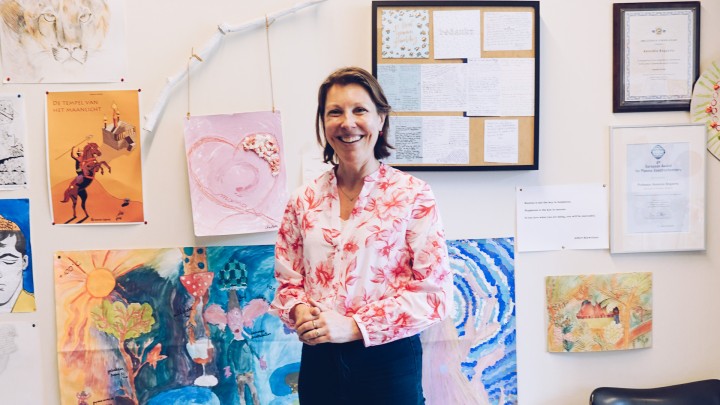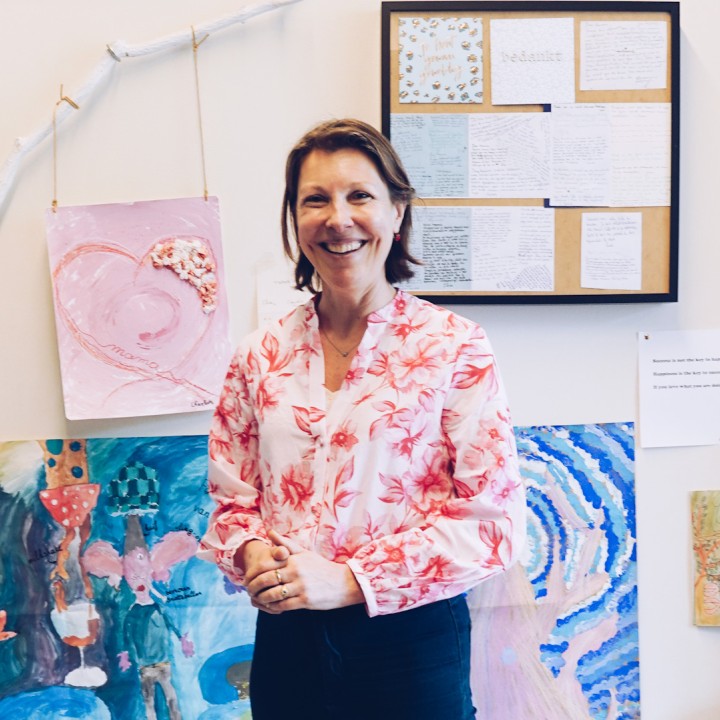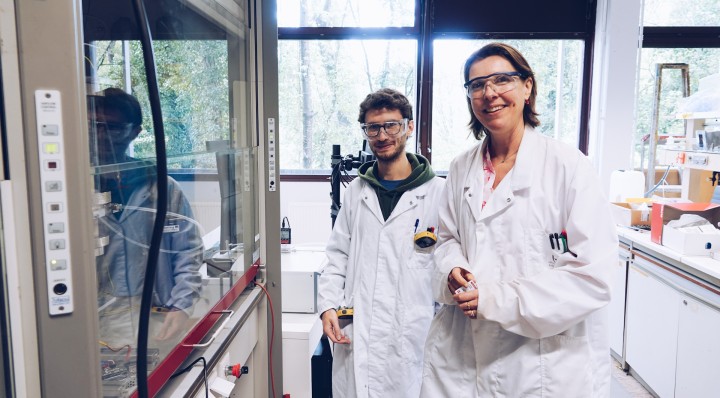“We are creating totally new opportunities for electrification of the chemical industry with plasma technology”
Chemistry professor Annemie Bogaerts (UAntwerpen) founded research group PLASMANT, which does research on the role of plasma reactors for gas conversion, relevant to process innovation, e.g. electrification in the chemical industry, but also on plasma applications in medical treatments. She heads PLASMANT and is also a passionate people manager for her team of fifty.

PLASMANT is providing research for three Moonshot projects, D2M, P2C and P2O, all within the MOT3 pathways of electrification and radical process transformation. The group is also partnering in Catalisti project BluePlasma.
Already during D2M in 2021, the jump was made to the spin-off D-CRBN, which today is working on a pilot plasma reactor that converts CO2 to carbon monoxide (CO) for reuse as a chemical building block for various products (e-fuel, polymers, chemicals). D-CRBN focuses on energy- and emission-intensive sectors such as chemicals, steel and maritime industries. Currently, D-CRBN’s pilot reactor is at ArcelorMittal for field testing.
Pioneer in plasma technology
Research on conversions using plasma technology started much earlier for Professor Annemie Bogaerts. “I had started plasma research from my own PhD. Twenty years ago, I started the PLASMANT research group for, among others, materials research.” The group first did computational research, developing theoretical models and using them for testing the feasibility of certain applications.
About ten years ago, interest in CO2conversion grew. “Immediately I thought plasma could play a role for this purpose”, says Bogaerts. The research group took a pioneering role. “We started working on it fairly quickly. Internationally, not many research groups were active in the field yet. Now more groups have started, but we still have a nice lead”, laughs Bogaerts.
This was low-level TRL (Technology Readiness Levels, ed.) research. PLASMANT did computer simulations that provided insight into the best plasma reactor designs. A small laboratory-scale plasma reactor was built fairly quickly. “Such a reactor treats a few liters per minute. The strength of our group is that we do experimental research supported by computer simulations to gain insight into reactor design. This is complemented by simulation of the plasma chemistry (reaction kinetics) to optimize it as well in our search for ideal conditions”, Professor Bogaerts explains.
|
Professor Bogaerts and PLASMANT see their influence reflected not only in the growing interest of companies, but also in the high citations of their papers. “We have several papers on CO2 conversion and other sustainable chemistry applications with plasma technology in major journals. In our main review paper, we performed a critical data analysis of all studies in literature. It is one of the most cited papers in our field”, Bogaerts said. “People from the industry told me the article is seen as a bible for plasma conversion. I'm quite proud of that.” Read the paper here. |
Dioxide to monoxide
For a long time, industry mainly looked at catalyst technology in chemical production. Plasma was one of five different technologies studied within Moonshot project D2M. Other technologies had previously received more attention. “Ten years ago, plasma received little attention in literature”, Bogaerts says. “But the recognition is growing. Plasma is not very well known yet, especially in the chemical industry, because not much is known on a higher TRL scale. It is a much smaller research area than, for example, electrochemistry (electrolysis of water) or photocatalysis. In those fields many more groups have been working for many years. Plasma, on the other hand, is only now beginning to boom.”
Plasma technology however has great potential. “Recent reports, also from MIT, have called electrocatalysis and plasma the main pathways to electrify the chemical industry. So not to replace fossil fuels as a heat source, but really to replace existing chemical processes”, Bogaerts says. Plasma applications are very promising in combination with renewable electricity. “The big advantage of a plasma reactor is that it runs on electricity and can be switched on and off very quickly. We need to move to electrification of the industry. Plasma is the ideal solution for that. The future is electric.”

The big advantage of a plasma reactor is that it runs on electricity and can be switched on and off very quickly. We need to move to electrification of the industry. Plasma is the ideal solution for that. The future is electric.
Spin-off D-CRBN
Before the start of D-CRBN, Georgi Trenchev, one of Bogaerts' doctoral students, played a key role. He wanted to scale up plasma technology. “That's why we applied for a two-year innovation mandate from VLAIO. That is a postdoc track to establish a spin-off. That's how the ball got rolling for starting up D-CRBN.” In that trajectory, the research group needed an industrial mentor. “We brought Gill Scheltjens on board. Gill eagerly convinced us to set up the spin-off immediately and not to wait for two more years of development. I'm very glad we took that step. Sometimes you must not be afraid to jump as a researcher”, says Bogaerts.
D-CRBN is specifically looking at plasma technology for CO2 conversion. “I am very proud of what D-CRBN is doing. It is a strong team that is winning prize after prize. They are now also getting European innovation support. I also see it a bit as my baby, because it grew out of our research”, Prof. Bogaerts laughs.
The BluePlasma project: pilot reactor
PLASMANT already had a commercial application in mind, but it is not obvious for a university research group to develop applications on a larger scale. D-CRBN, as a company, can do this and has access to other funding. “As a company, you are more agile and have access to other funding channels”, Bogaerts says.
With Catalisti as innovation broker, D-CRBN submitted the ICON project BluePlasma. D-CRBN is coordinating. PLASMANT is one of the partners, together with VITO and companies such as ArcelorMittal, BASF and Vopak. In BluePlasma, plasma is used for the benefit of a carbon-neutral industry.
Within BluePlasma, PLASMANT is conducting basic strategic research (SBO) to further improve the conversion process. “We have placed a carbon bed behind the plasma. This allowed us to dramatically increase CO2 conversion and CO yield, and also to reduce the separation costs. The carbon bed needs to be continuously refreshed to keep the results at a stable level. We have also been working on that solution. D-CRBN has implemented this in their pilot reactor as well.”
Prof. Bogaerts is excited about the planned testing of D-CRBN at ArcelorMittal: “By working with industrial CO2 emissions, we can convince companies that it also works in real-world setups.”
Other industrial applications
The PLASMANT group is looking into more applications than CO2 conversion alone. “We want to electrify various chemical processes. Our main goal is to increase energy efficiency and product yield”, Bogaerts clarified. “Converting CO2 and methane via syngas to higher hydrocarbons and oxygenated compounds is done in classical methods using sequential processes that all require energy. With plasma technology, this can be done all at once, with the right catalyst. However, research is still needed on the interaction between plasma and the most optimal catalyst.”

The P2C project: beating Haber-Bosch
A very good example of how PLASMANT aims for higher valorization is the cracking of ammonia for the sustainable production of green hydrogen, but also vice versa, making ammonia as well as NOx for the sustainable production of green fertilizers. “We make the basis of fertilizers in a green way. Just based on air, green electricity and using a plasma reactor.” For this, PLASMANT is collaborating with Johan Martens' group. The research is taking place at the Leuven TRANSfarm site. "This research helps to address the 'nitrogen emission' problem, more specifically by having ammonia emissions from stables react with plasma-produced NOX to make ammonium nitrate.”
The idea started from the Moonshot project P2C that Prof. Bogaerts conducted with Johan Martens. “When Johan Martens saw our laboratory with plasma reactors, the idea of further cooperation was born. In P2C we made ammonia, but now we are capturing the ammonia and making ammonium nitrate.” The project received support from Flemish Agriculture Minister Jo Brouns. “The government is demanding solutions to the manure problem.”
PLASMANT also conducts techno-economic analyses to gain insight into the price tag, among other things. “For example, we have shown that to be competitive with the industrial process (Haber-Bosch and Ostwald) for fertilizer production we need to achieve an energy cost of 1-1.5 MJ/mole (nitrogen). We are now at 1.8 MJ/mole. We are not quite there yet, but we will reach this target.”
Three years ago, the best papers stated a result of 3 MJ/mole. Improved reactor designs and improved conditions are the key elements being looked at. There is still room for improvement. Initially, the focus was mainly on improving the plasma reactor, but improvement is also possible after the plasma process. Some of the products formed recombine after the plasma, but the group believes they can 'quench', or freeze rapidly, so that the products do not recombine. “There is still a lot of improvement to be made there”, Bogaerts says.
More examples needed at higher TRL scaleFor plasma, not many examples on a higher TRL scale are yet known. Nevertheless, a lot of applications are possible. “Increasingly we are demonstrating this”, says Bogaerts. “CO2 conversion and NOX production via plasma are already two very successful examples.” Bogaerts lists other applications: CO2 -methane to methanol, CO2 -methane to syngas, CO2 -hydrogen to methanol, methane to hydrogen, methane to ethylene. For the latter, an ongoing Moonshot project has been set up (P2O) together with the LCT research group at Ghent University, among others, in which PLASMANT is working on plasma as one of the methodologies. New applications are emerging as well. Ammonia cracking for hydrogen production is also being looked at by PLASMANT together with Johan Martens, supported by the Energy Transition Fund. “Four years ago, I would not have thought of such an application”, Bogaerts admits, until Waterstofnet suggested to use ammonia for hydrogen and inquired whether plasma would be suitable for it. “Then you take some time to think about it. If the chemistry is right, try it. I find that fascinating.” |
Bogaerts believes the group's success due to the attitude they all share. “Believing at the right time that there is a story in the research and then jump into it.” Nevertheless, before moving into the applications, we perform a lot of basic research. Finding funding was no easy feat in the first few years, but gained momentum through an ERC (European Research Council) project, a good CV and scientific merit. Bogaerts concludes, “My motto is: it is nice to do research that is interesting and super exciting, but even nicer if it is also relevant, to many applications. I believe we can really make a difference with plasma technology.”